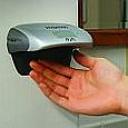Changing Hand Washing Behavior
Friday, June 12th, 2009 Washing your hands, especially if you are clinician caring for patients in a hospital, is serious business. It is a key for avoiding the spread of infection and keeping patients safe. Yet it is hard to get 100% compliance with established hand washing safety practices.
Washing your hands, especially if you are clinician caring for patients in a hospital, is serious business. It is a key for avoiding the spread of infection and keeping patients safe. Yet it is hard to get 100% compliance with established hand washing safety practices.
A classic cognitive design challenge.
EurekAlert! reports on an interesting new approach developed at the University of Florida. Billed as Soap-sniffing technology encourages hand washing to reduce infections, save money, here is how it works:
“The health-care worker squirts sanitizer gel or soap into his or her hand before passing it under a wall-mounted sensor. A wireless signal from a badge worn by the worker activates a green light on the hand-washing sensor. When the worker enters a patient room, a monitor near the bed detects the status of the badge, and flashes green if the person has clean hands. If the person has not washed, or too much time has passed between washing and approaching the patient, the badge will give a gentle “reminder” vibration.”
 This may seem like too much technology for a behavioral issue, but hand washing in hospitals has turned out to be a very hard condition to manage. The approach is called HyGreen and it is important because it closes the loop electronically and provides an automated way to monitor and report on compliance. Something that is a known and powerful behavior changer.
This may seem like too much technology for a behavioral issue, but hand washing in hospitals has turned out to be a very hard condition to manage. The approach is called HyGreen and it is important because it closes the loop electronically and provides an automated way to monitor and report on compliance. Something that is a known and powerful behavior changer.